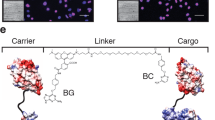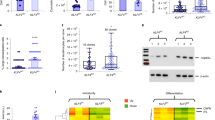Abstract
Gene transfer into the skin is a promising approach to treat inherited or acquired dermatological diseases and systemic monogenic deficiencies. For this purpose, the efficient and sustained gene delivery into keratinocytes is of critical importance. Recombinant adeno-associated virus (rAAV) vectors hold the potential to achieve a long-term gene transfer into various human organs. In order to evaluate this potential for skin gene therapy, human keratinocytes were transduced in vitro with rAAV vectors encoding the reporter genes β-galactosidase (rAAV/LacZ) or green fluorescent protein (rAAV/GFP). Using rAAV/LacZ at a multiplicity of infection (MOI) of five transducing particles per cell, up to 70% of human keratinocytes were trans- duced within 48 h. This effect was independent of individual skin donors and different body areas serving as the source for keratinocyte isolation. rAAV had no significant influence on cell viability, but induced a growth arrest in transduced keratinocytes. This growth arrest was overcome by replating cells in fresh media. rAAV/GFP-transduced keratinocytes could be passaged several times, expressed GFP for up to 50 days, and passed the transgene to their daughter cells, suggesting that keratinocyte precursor cells were also transduced. Taken together, the results suggest that rAAV is a promising gene transfer vehicle for skin gene therapy.
This is a preview of subscription content, access via your institution
Access options
Subscribe to this journal
Receive 12 print issues and online access
$259.00 per year
only $21.58 per issue
Buy this article
- Purchase on Springer Link
- Instant access to full article PDF
Prices may be subject to local taxes which are calculated during checkout





Similar content being viewed by others
References
Rheinwald JG, Green H . Serial cultivation of strains of human epidermal keratinocytes: the formation of keratinizing colonies from single cells Cell 1975 6: 331–344
Wang X, Zinkel S, Polonsky K, Fucks E . Transgenic studies with a keratin promotor-driven growth hormone transgene Proc Natl Acad Sci USA 1997 94: 219–226
Navsaria HA, Myers SR, Leigh IM, McKay IA . Culturing skin in vitro for wound therapy TIBTECH 1995 13: 91–100
Braun-Falco M, Hallek M . Hautgentherapie-Perspektiven des Gentransfers in Keratinozyten Hautarzt 1998 49: 536–544
Fenjves ES . Approaches to gene transfer in keratinocytes J Invest Dermatol 1994 103: 70S–75S
Greenhalgh DA, Rothnagel JA, Roop DR . Epidermis: an attractive target tissue for gene therapy J Invest Dermatol 1994 103: 63S–69S
Krueger GG et al. Genetically modified skin to treat disease: potential and limitations J Invest Dermatol 1994 103: 76S–84S
Vogel JC, Walker PS, Hengge UR . Gene therapy for skin diseases Adv Dermatol 1996 11: 383–398
Andree C et al. In vivo transfer and expression of a human epidermal growth factor gene accelerates wound repair Proc Natl Acad Sci USA 1994 91: 12188–12192
Eming SA et al. Genetically modified human epidermis overexpressing PDGF-A directs the development of a cellular and vascular connective tissue stroma when transplanted to athymic mice-implications for the use of genetically modified keratinocytes to modulate dermal regeneration J Invest Dermatol 1995 105: 756–763
Sun L et al. Transfection with aFGF cDNA improves wound healing J Invest Dermatol 1997 108: 313–318
Carreau M et al. Functional retroviral vector for gene therapy of xeroderma pigmentosum group D patients Hum Gene Ther 1995 6: 1307–1315
Zeng L et al. Retrovirus-mediated gene transfer corrects DNA repair defect of xeroderma pigmentosum cells of complementation groups A, B and C Gene Therapy 1997 4: 1077–1084
Jensen TG et al. Correction of steroid sulfatase deficiency by gene transfer into basal cells of tissue-cultured epidermis from patients with recessive X-linked ichthyosis Exp Cell Res 1993 209: 392–397
Choate KA, Medalie DA, Morgan JR, Khavari PA . Corrective gene transfer in the human skin disorder lamellar ichthyosis Nature Med 1996 2: 1263–1267
Choate KA et al. Transglutaminase1 delivery to lamellar ichthyosis keratinocytes Hum Gene Ther 1996 7: 2247–2253
Fenjves ES, Schwartz PM, Blaese RM, Taichman LB . Keratinocyte gene therapy for adenosine deaminase deficiency: a model approach for inherited metabolic disorders Hum Gene Ther 1997 8: 911–917
Gerrard AJ, Hudson DL, Brownlee GG, Watt FM . Towards gene therapy for haemophilia B using primary human keratinocytes Nat Genet 1993 3: 180–183
DeLuca M, Pellegrini G . The importance of epidermal stem cells in keratinocyte-mediated gene therapy Gene Therapy 1997 4: 381–383
Fenjves ES, Yao S-N, Kurachi K, Taichman LB . Loss of expression of a retrovirus-transduced gene in human keratinocytes J Invest Dermatol 1996 106: 576–578
Mathor MB et al. Clonal analysis of stably transduced human epidermal stem cells in culture Proc Natl Acad Sci USA 1996 93: 10371–10376
Hallek M et al. Recombinant adeno-associated virus vectors Curr Res Mol Ther 1998 1: 417–430
Kremer EJ, Perricaudet M . Adenovirus and adeno-associated virus mediated gene transfer Br Med Bull 1995 51: 31–44
Flotte TR, Carter BJ . Adeno-associated virus vectors for gene therapy Gene Therapy 1995 2: 357–362
Kotin RM . Prospects for the use of adeno-associated virus as a vector for human gene therapy Hum Gene Ther 1994 5: 793–801
Samulski RJ . Adeno-associated virus: integration at a specific chromosomal locus Curr Opin Genet Dev 1993 3: 74–80
Muzyczka N . Use of adeno-associated virus as a general transduction vector for mammalian cells Curr Top Microbiol Immunol 1992 158: 97–127
Xiao X, Li J, Samulski RJ . Production of high-titer recombinant adeno-associated virus vectors in the absence of helper adenovirus J Virol 1998 72: 2224–2232
Chiorini JA et al. High-efficiency transfer of the T cell co-stimulatory molecule B7–2 to lymphoid cells using high-titer recombinant adeno-associated virus vector Hum Gene Ther 1995 6: 1531–1541
Flotte TR et al. An improved system for packaging recombinant adeno-associated virus vectors capable of in vivo transduction Gene Therapy 1995 2: 29–37
Podsakoff G, Wong KKJ, Chatterjee S . Efficient gene transfer into nondividing cells by adeno-associated virus-based vectors J Virol 1994 68: 5656–5666
Alexander IE, Russel DW, Miller D . DNA-damaging agents greatly increase the transduction of nondividing cells by adeno-associated virus vectors J Virol 1994 68: 8282–8287
Xiao X, Li J, Samulski RJ . Efficient long-term gene transfer into muscle tissue of immunocompetent mice by adeno-associated virus vector J Virol 1996 70: 8098–8108
Monahan PE et al. Direct intramuscular injection with recombinant AAV vectors results in sustained expression in a dog model of hemophilia Gene Therapy 1998 5: 40–49
Snyder RO et al. Efficient and stable adeno-associated virus-mediated transduction in the skeletal muscle of adult immunocompetent mice Hum Gene Ther 1997 8: 1891–1900
Afione SA et al. In vivo model of adeno-associated virus vector persistence and rescue J Virol 1996 70: 3235–3241
Conrad CK et al. Safety of single-dose administration of an adeno-associated virus (AAV)-CFTR vector in the primate lung Gene Therapy 1996 3: 658–668
Kaplitt MG et al. Long-term gene expression and phenotypic correction using adeno-associated virus vectors in the mammalian brain Nat Genet 1994 8: 148–154
Flotte TR et al. Stable in vivo expression of the cystic fibrosis transmembrane conductance regulator with an adeno-associated virus vector Proc Natl Acad Sci USA 1993 90: 10613–10617
Kaplitt MG et al. Long-term gene transfer in porcine myocardium after coronary infusion of an adeno-associated virus vector Ann Thorac Surg 1996 62: 1669–1676
Fisher KJ et al. Recombinant adeno-associated virus for muscle directed gene therapy Nature Med 1997 3: 306–312
Manning WC et al. Transient immunosuppression allows transgene expression following readministration of adeno-associated virus vectors Hum Gene Ther 1998 9: 477–485
Descamps V, Blumenfeld N, Beuzard Y, Perricaudet M . Keratinocytes as a target for gene therapy Arch Dermatol 1996 132: 1207–1211
Klein-Bauerschmitt P, zur Hausen H, Schlehofer JR . Induction of differentiation-associated changes in established human cells by infection with adeno-associated virus type 2 J Virol 1992 66: 4191–4200
Maass G et al. Recombinant adeno-associated virus vectors for the generation of autologous, gene-modified tumor vaccines: evidence for a high transduction efficiency into primary epithelial cancer cells Hum Gene Ther 1998 9: 1049–1059
Lane EB, Alexander CM . Use of keratin antibodies in tumour diagnosis Semin Cancer Biol 1990 1: 165–179
Van Muijen GNP, Warnaar SO, Ponec M . Differentiation-related changes of cytokeratin expression in cultured keratinocytes and in fetal, newborn, and adult epidermis Exp Cell Res 1987 171: 331–345
Ponnazhagan S et al. Adeno-associated virus type 2-mediated transduction in primary human bone marrow-derived CD34+ hematopoietic progenitor cells: donor variation and correlation of transgene expression with cellular differentiation J Virol 1997 71: 8262–8267
Nead MA, McCance DJ . Poly-L-ornithine-mediated transfection of human keratinocytes J Invest Dermatol 1995 105: 668–671
Deng H, Lin Q, Khavari PA . Sustainable cutaneous gene delivery Nat Biotech 1997 15: 1388–1391
Russell DW, Alexander IE, Miller AD . DNA synthesis and topoisomerase inhibitors increase transduction by adeno-associated virus vectors Proc Natl Acad Sci USA 1995 92: 5719–5723
Verma IM . ‘Green light’ for gene transfer Nat Biotech 1996 14: 576
Kube DM, Ponnazhagan S, Srivastava A . Encapsidation of adeno-associated virus type 2 rep proteins in wild-type and recombinant progeny virions: Rep-mediated growth inhibition of primary human cells J Virol 1997 71: 7361–7371
Jiang C-K, Connolly D, Blumenberg M . Comparison of methods for transfection of human epidermal keratinocytes J Invest Dermatol 1991 97: 969–973
Staedel C et al. High-efficiency transfection of primary human keratinocytes with positively charged lipopolyamine:DNA complexes J Invest Dermatol 1994 102: 768–772
Sawamura D et al. In vivo transfer of a foreign gene to keratinocytes using the hemagglutinating virus of Japan-liposome method J Invest Dermatol 1997 108: 195–199
Lu B et al. Topical application of viral vectors for epidermal gene transfer J Invest Dermatol 1997 108: 803–808
Surosky RT et al. Adeno-associated virus Rep proteins target DNA sequences to a unique locus in the human genome J Virol 1997 71: 7951–7959
Ferrari FK, Samulski T, Shenk T, Samulski RJ . Second-strand synthesis is a rate-limiting step for efficient transduction by recombinant adeno-associated virus vectors J Virol 1996 70: 3227–3234
Fisher KJ et al. Transduction with recombinant adeno-associated virus for gene therapy is limited by leading-strand synthesis J Virol 1996 70: 520–532
Doll RF et al. Comparison of promoter strengths on gene delivery into mammalian brain cells using AAV vectors Gene Therapy 1996 3: 437–447
Dong J-Y, Fan P-D, Frizzell RA . Quantitative analysis of the packaging capacity of recombinant adeno-associated virus Hum Gene Ther 1996 7: 2101–2112
Sanes JR, Rubenstein JLR, Nicolas J-F . Use of a recombinant retrovirus to study post-implantation cell lineage in mouse embryos EMBO J 1986 5: 3133–3142
Leigh IM, Watt FM . Keratinocyte Methods Cambridge University Press: Cambridge 1994
Jones PH, Watt FM . Separation of human epidermal stem cells from transit amplifying cells on the basis of differences in integrin function and expression Cell 1993 73: 713–724
Author information
Authors and Affiliations
Rights and permissions
About this article
Cite this article
Braun-Falco, M., Doenecke, A., Smola, H. et al. Efficient gene transfer into human keratinocytes with recombinant adeno-associated virus vectors. Gene Ther 6, 432–441 (1999). https://doi.org/10.1038/sj.gt.3300815
Received:
Accepted:
Published:
Issue Date:
DOI: https://doi.org/10.1038/sj.gt.3300815
Keywords
This article is cited by
-
Evaluation of prenatal intra-amniotic LAMB3 gene delivery in a mouse model of Herlitz disease
Gene Therapy (2006)
-
Restoration of fatty aldehyde dehydrogenase deficiency in Sjögren–Larsson syndrome
Gene Therapy (2006)
-
Recombinant adeno-associated virus type 2-mediated gene transfer into human keratinocytes is influenced by both the ubiquitin/proteasome pathway and epidermal growth factor receptor tyrosine kinase
Archives of Dermatological Research (2005)
-
Adeno-associated virus vectors are able to restore fatty aldehyde dehydrogenase-deficiency. Implications for gene therapy in Sjögren-Larsson syndrome
Archives of Dermatological Research (2005)
-
Recombinant AAV vector encoding human VEGF165 enhances wound healing
Gene Therapy (2002)



